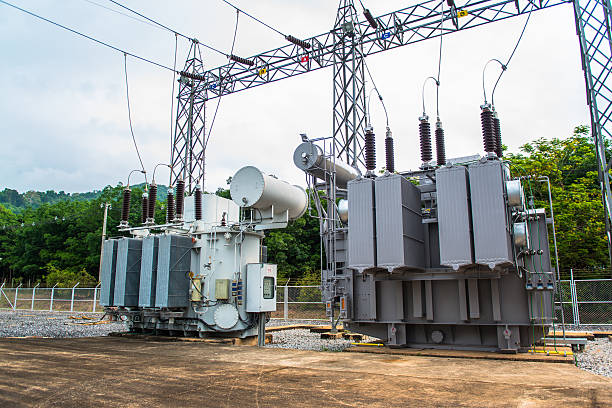Understanding the Powerhouse: What is a 500 kva Transformer?
A 500 KVA transformer designated 500 kVA may manage up to 500,000 VAs of perceived power. To put it another way, it serves as a voltage converter, usually scaling down high voltage from the main power grid to a lower voltage appropriate for powering other machinery and equipment.
Understanding kVA vs. kW: Don’t Get Confused by the Numbers
Understanding the difference between kVA and kW (kilowatt) is essential. A transformer’s total apparent power is expressed in kVA, while its actual true power is shown in kW. Useful power output is represented by kW, but the entire electrical load that a transformer can manage is represented by kVA. The kW rating is often less than the kVA rate. To have a more profound comprehension of kVA vs. kW, consult this useful resource:
Unveiling the Applications: Where 500 kva Transformers Shine?
These applications of 500 kva transformer are perfect for a variety of uses due to their flexibility. Here are a few well-known instances:
Industrial facilities: Supplying electricity to control panels, lighting fixtures, and machinery in industrial facilities, workshops, and factories.
Commercial buildings: Providing power for air conditioning units, elevators, lights, and other equipment in stores, restaurants, and offices.
Large residential buildings: Providing electricity to several apartments, condos, or gated communities.
Applications in agriculture: supplying electricity for ventilation systems, grain processing machinery, and irrigation pumps.
Construction sites : Provide short-term electricity for equipment, lights, and tools while building projects are underway.
Mining: One of the most important uses for these transformers is powering conveyor belts, crushers, and ventilation systems in mining operations.
Oil and Gas : These transformers are used in refineries and processing facilities to power compressors, pumps, and other equipment used in the extraction and processing of oil and gas.
Data Centers: Although rare, some very big data centers with very high-power requirements may use these transformers for certain sections that need a lot of power.

A Look at the Dimensions and Weight of the 500 kva Transformer:
A commercial transformer actual weight and dimensions might vary according to the manufacturer and type, although they usually fall into a range. Here’s an overview:
Dimensions 500 kVA transformer dimensions: 800-1200 mm in width, 1800-2500 mm in length, and 1500-2000 mm in height.
Weight 500 kVA transformer : 6,600–11,00 pounds
Because of its weight, it’s crucial to make sure you have enough room for the transformer installation. When choosing pole-mounted transformers, weight is an important consideration.
Understanding the Options: Single-Phase vs. Three-Phase Transformers
There are two primary variants for industrial transformer: 3 phase vs single-phase transformer. The best option for you will depend on your particular application:
Single phase : Transformers with a single phase are appropriate for lower-power applications, such as those found in homes or small businesses. They make use of a single circuit with alternating current (AC).
3 phase: To handle larger loads, three-phase transformers are more frequently seen in industrial applications . They are more efficient in powering three-phase motors and equipment because they make use of three AC circuits.
Selecting the Perfect Fit: Key Considerations for Choosing a 500 kVA Transformer
To make sure the 500 kVA transformer you choose will fulfill your demands, you should take into account the following factors:
Phase Configuration:
As was previously said, think about whether you require a single-phase or three-phase transformer.
Cooling Type:
There are two common cooling arrangements for electrical transformer transformers: oil-filled and dry-type.
Voltage Input and Output:
Determine the main voltage (incoming voltage) and secondary voltage (outgoing voltage) needed for your application. For these transformers, standard primary voltage options may be 13.8 kV, 22 kV, or 34.5 kV, while standard secondary voltage options might be 480V, 208V , or 240V.
How much power can a 500 kVA transformer handle?
The apparent power handling capacity of a transformer is indicated by its KVA rating. The highest load that a 500 kVA transformer can manage is 500 kVA. However, operating the transformer below its full capacity—typically about 80%, or 400 kVA—is advised for best results and lifetime. This avoids overloading and provides headroom, particularly during periods of peak consumption.
How to install a 500 kVA transformer?
- Planning and Permitting:
Speak with an electrical engineer to choose the best place for the transformer , taking into account elements like ventilation, accessibility, and closeness to electrical loads. Before installation, it is essential to get the required approvals from the relevant municipal authorities.
- Foundation and Lifting:
It is important to have a strong foundation that can bear the weight of the transformer. It is advised to use certified crane operators for safe and effective lifting and installation.
- Electrical Connections:
To ensure correct grounding and compliance with electrical rules, qualified electricians will handle high-voltage connections to the transformer’s primary and secondary windings.
- Testing and Commissioning:
Extensive testing, such as insulation resistance, load testing, and protective relay testing, is carried out following installation to ensure correct functioning.
Maintenance for a 500 kVA transformer:
Frequent Inspections: To spot such problems early on, trained professionals must schedule inspections. Usually, visual inspections are performed to look for leaks, loose connections, and overheating symptoms.
Oil Maintenance (Oil-Immersed Transformers): To detect probable breakdown products that might cause transformer failure and to monitor the health of the oil, frequent oil samples and analysis are required. Depending on the findings of the analysis, oil changes can be necessary.
Maintenance of Cooling Systems: Check and clean cooling systems (fans, filters) to ensure adequate heat dissipation and airflow.
Record Keeping: To monitor the transformer’s condition and plan for future maintenance, it is essential to keep thorough records of all inspections, repairs, and test results.
Conclusion:
Selecting Shinenergy means selecting a trustworthy partner for your needs related to industrial power. Get in touch with us right now to go over your unique needs and discover how our transformers can enhance your business processes.

